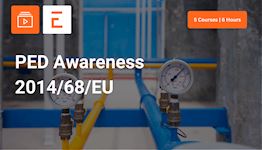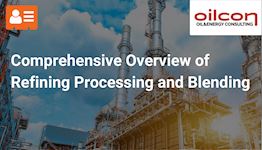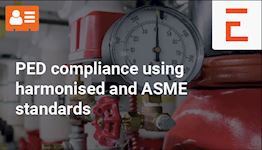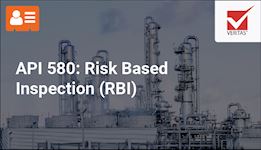Managing Flow Assurance in Oil and Gas Production
Why take this course?
Master flow assurance fundamentals for safe, efficient hydrocarbon delivery from wells to facilities. This multidisciplinary course covers multiphase flow properties, pressure loss calculations, and solutions for slugging, hydrate plugging, and wax formation challenges. Includes video lectures, interactive quizzes, and hands-on examples, with certificate offering PDH credits.
What you'll learn
After this course, you...
• understand the multiphase flow equations, their fundamental principles and their derivation,
• are familiar with the different flow regimes, such slugging and bubbling flow, and understand under which conditions these develop,
• have seen how the challenges associated with the different flow regimes, most significantly those with slugging, can be managed,
• have seen how hydrate formation occurs and how this can develop into plugs,
• have had chance to put your skills into practice through cases and a mini• project based on practical experience of the instructor,
• are familiar with running numerical software for flow assurance, and have experienced the common pitfalls and have seen how these can be avoided and identified.
About the course
Flow Assurance is a multi-disciplinary activity which covers all methods to ensure the safe and efficient delivery of hydrocarbons from the well to the collection facilities. Flow assurance technology regularly allows mixtures of oil, gas and water to be transported in the same flowline across long distances, meaning that local separation at the wellheads can be avoided. However, cost-effective and reliable multiphase transport comes with its own set of challenges.
This training course introduces the participants to flow assurance, the properties of multiphase flows, how to calculate the losses, and how to avoid potential problems like slugging, hydrate plugging or wax formation. There are lots of example cases and a group mini-project in the training course giving the participants plenty of chance to put the theory into practice.
Dr. Bratland has written two books on flow assurance, and they will be used as reference during the course and a softcopy version of these will be given to the participants. The course will include running flow assurance simulation software, and the participants are encouraged to bring their laptops.
Who should attend this course
Technical professionals who are involved in the design or operation of projects where flow assurance plays a role, such as:• Pipeline engineers and Operators,
• Well engineers and Production engineers
• Flow assurance and Mechanical engineers
Prerequisites
Some affinity with oil and gas transportation, and the challenges associated with flow assurance is beneficialProgram & Details
-
Day 1 Part 1 - Introduction
Live
1. Introduction to flow regimes
2. Introduction to the most common flow assurance challenges we are faced with, and the main ways of dealing with them
Exercise 1: The Ormen Lange field or another offshore field. Which of the problems mentioned in the introduction today could potentially create problems on this field? How were they solved? Could any of the problems have been solved in different ways? -
Day 1 Part 2 - Friction
Live
1. The main mechanisms causing friction
2. Friction in single-phase flow, well-mixed bubbly flow, stratified flow and annular flow
3. How non-Newtonian fluids can affect the friction
4. Introduction to how terrain and flow regime affects friction and other sources of pressure drop (this is more thoroughly explained when discussing each flow regime later)
Exercise 2: Manual calculation of the friction types described in this section. Illustration of how the results give us indications regarding which flow regimes to expect. Doing manual checks of results coming out of multiphase simulation programs. -
Day 2 Part 1 - The Multi phase pipeflow equations
Live
1. The development of the equations will be shown briefly, the main emphasis will be on the understanding the principles built into them and which closure correlations they require
2. Description of what the closure terms describe, and how some of them can be estimated manually
3. Principles for steady-state solution of the equations with example illustrations
4. Heat calculations: Various types (steady-state, quasi-steady-state and fully transient), how accurate they are, and which input-data they require
Exercise 1: Examples of ways we can check results coming out of commercial simulations by manually calculating some of the closure equations, particularly pressure drop. -
Day 2 Part 2 - Transient Phenomena
Live
1. How various flow regimes develop
2. Flow regime maps for various inclinations, particularly vertical and horizontal
3. How to estimate the location of important points in the flow regime maps
Exercise 2: Simulating a simple mechanical system (a mass and a spring damper) with two different integration methods. The emphasis is on how user settings affect the simulations, the source of some of the errors we need to guard against and which sometimes my cause the simulations to 'crash'. The intention is to give an understanding of the numerics built into commercial software, without needing to go into details about the theory.
Exercise 3: A (simple-to-use) simulation program is used for simulating transient dispersed bubble flow in a flowline. The gas fraction is varied to investigate how it affects friction, capacity and the potential for pressure surges. The results are animated for ease of teaching. If time allows, another (also simple-to-use) simulation program will be used to illustrate stratified flow by an illustrative animation generated in real time. -
Day 3 Part 1 - PVT Properties, Hydrates and Other Deposits
Live
1. Which fluid properties are relevant, and how do we determine them? Equation of state and other ways of modeling the properties. How the properties relate to Flow Assurance
2. Oil sampling: How samples are taken and what they can tell us
3. How to avoid fluid temperatures (design and operational issues), and why these can cause problems
4. Pigging operations, chemical injection and other ways to prevent deposits
5. Sand management, where sand tends to become a problem, and common counter measures to manage corrosion, erosion and cavitation
6. Emulsions: how they form, what they may cause (such as higher pressure how they form, what they may cause (such as higher pressure loss due to friction, and also a less predictable and even varying loss). Models for estimating emulsion viscosity
7. Limits to what is currently possible (the PVT-related limitations such as inaccuracies due to representative oil samples being difficult to obtain, particularly at an early project stage; the fact that even when good samples are available, some properties are difficult to predict accurately, particularly emulsions; heat caused by hydrate formation not being accounted for in current models; the strong interaction between chemical and fluid mechanical approximations enhancing each other)
8. The Joule-Thompson effect and other real gas peculiarities affecting fluid temperature and hydrate formation
Exercise 1: Interpreting hydrate envelopes coming out of PVT-software or flow assurance simulators. The exercise is not based on the participants running the software, but discussing the curves they are given on paper.
-
Day 3 Part 2 - Slugs
Live
1. More about different flow regimes, particularly slugging, and how two-phase flow differs from three-phase flow
2. Different types of slugs. Slug lengths and slug periods. Statistical variation
3. How to manage slugs, both operational and design issues
4. Gas lift: how to use it to manage slugs and/or increase production. Various types of gas lift, how to optimize production
5. Slug catchers and slug catcher design
6. How slugs affects tendencies to get hydrates
7. Example case: Active slug suppression at Statoil's Aasgard-field or another field where active slug suppression has been suggested implemented
Exercise 2: Interpreting simulation results showing slugging in a well and a pipeline. The participants are given the results on paper and asked questions about them. -
Day 4 Part 1 - Operational Issues
Live
1. Operational envelopes
2. How pressure surges and slugs may reveal themselves as pressure variations, and how to distinguish them
3. How beginning hydrate formation may reveal itself, and what to do about it
4. How way buildup may reveal itself
5. How to remediate hydrate plugs
6. Leak detection
7. Liquid loading in wet gas wells
Exercise 1: Discussing an operational envelope for a particular field. -
Day 4 Part 2 - Mini Projects
Live
Pick a field where flow assurance is important. Prepare a short presentation (around 15 minutes), to be presented to the other participants on the course. Expect questions and comments from the audience.
-
Day 5 Part 1 - Various Advanced Subjects
Live
1. More about commercial simulation software. What existing programs can and cannot do, and how they are likely to develop in the future
2. Factors affecting internal corrosion
3. Brief introduction of multiphase flow measurement
4. Some extra considerations for flow in wells
5. Example illustration of the forces involved in annular two-phase flow. -
Day 5 Part 2 - Exercise utilizing what has been covered in the course.
Live
Exercise 1: Interpretation of a well simulation where the flow stops. Discussion of how this can happen, and how to avoid it.
Exercise 2: Erosion calculations using API RP 14E Recommended Practice for Design and Installation of Offshore Production Platform Piping Systems and DNV Recommended Practice RP O501 Erosive Wear In Piping Systems.
Exercise 3: Heat loss calculations. Examples of how to use manual heat calculations to estimate the temperature reduction in a flowline, and how to use it to check results from commercial software.
Exercise 4: Interpretation of a steady-state network simulation.
Exercise 5: Exercise related to the Stockman-field or another offshore gas field
1. Closing notes
2. Where to find more information
3. Summary and discussion of the course
Certification
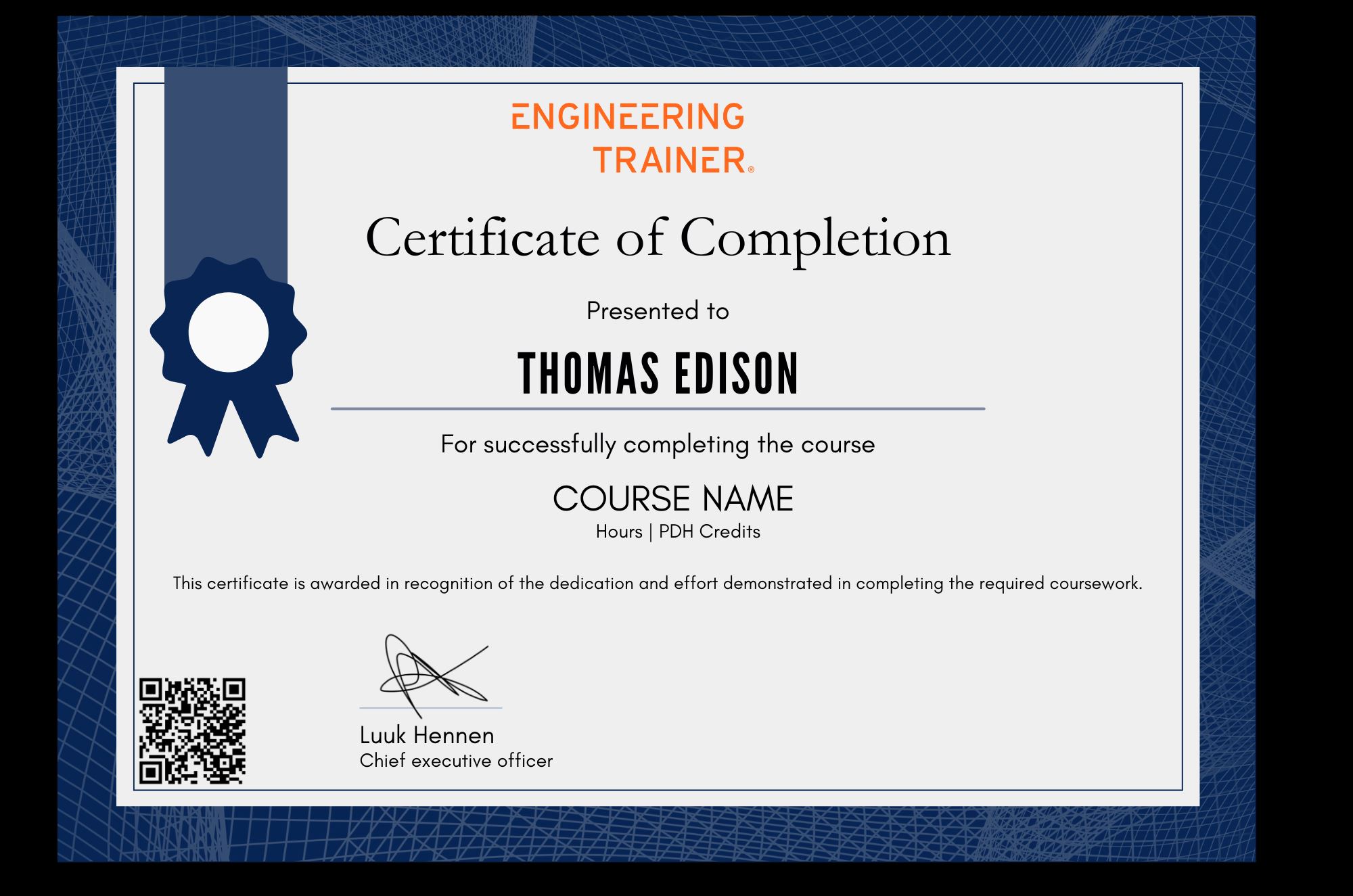

Why choose EngineeringTrainer
-
Unlimited Team-wide Access
-
Advance Technical Competences
-
Courses by Industry Authorities
Since using EngineeringTrainer our internal mentorship has a much more matured character.
Logan Chapman - COO at Chapman Consulting Inc.





